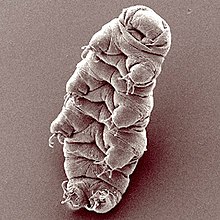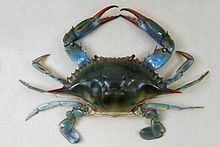| Tactopoda Temporal range:
| |
|---|---|

| |
| The tardigrade Hypsibius dujardini | |

| |
| The blue crab Callinectes sapidus, an arthropod | |
| Scientific classification | |
| Domain: | Eukaryota |
| Kingdom: | Animalia |
| Subkingdom: | Eumetazoa |
| Clade: | ParaHoxozoa |
| Clade: | Bilateria |
| Clade: | Nephrozoa |
| (unranked): | Protostomia |
| Superphylum: | Ecdysozoa |
| (unranked): | Panarthropoda |
| (unranked): | Tactopoda Budd, 2001[1] |
Tactopoda or Arthropodoidea is a proposed clade of ecdysozoan animals that includes the phyla Tardigrada and Euarthropoda, supported by various morphological observations.[1][2][3] The cladogram below shows the relationships implied by this hypothesis.
| Panarthropoda |
| |||||||||
The competing hypothesis is that Antennopoda[4][5] (= Euarthropoda + Onychophora, the arthropods and the velvet worms) is monophyletic,[6] and tardigrades lie outside this grouping.
Anatomic arguments for the tactopoda monophyly include similarities in the anatomies of head, legs, and muscles between the arthropods and the tardigrades. Anatomic arguments against it include that tardigrades lack the kind of circulatory system (including a dorsal heart) which the arthropods and the velvet worms share. Graham Budd argued that the lack of this system in recent tardigrades is due to their miniature size, which makes a complex circulatory system superfluous; thus, the loss of this feature would be a secondary property, acquired as the tardigrade stem group turned smaller, and both the Euarthropoda+Onychophora circulatory system and a relatively large size should be a feature of the last common ancestor of all three groups.[1] However, Gregory Edgecombe also invoked phylogenomic evidence in favour of the alternative Euarthropoda+Onychophora grouping.[6]
- ^ a b c Graham E. Budd (2001). "Tardigrades as 'stem-group arthropods': the evidence from the Cambrian fauna" (PDF). Zoologischer Anzeiger. 240 (3–4): 265–279. doi:10.1078/0044-5231-00034. Archived from the original (PDF) on 2016-03-03.
- '^ Smith, M. R.; Ortega-Hernández, J. (2014). "Hallucigenias onychophoran-like claws and the case for Tactopoda". Nature. 514 (7522): 363–366. Bibcode:2014Natur.514..363S. doi:10.1038/nature13576. PMID 25132546. S2CID 205239797.
- ^ De Haro, A. (1998). "Origen y relaciones fitogenéticas entre Artrópodos, Onicóforos, Anélidos y Lofoforados, según datos moleculares y morfológicos". Boletín de la Real Sociedad Española de Historia Natural Sección Biológica. 94 (1–2): 103–113.
- ^ Smith, Frank W.; Goldstein, Bob (2017-05-01). "Segmentation in Tardigrada and diversification of segmental patterns in Panarthropoda". Arthropod Structure & Development. Evolution of Segmentation. 46 (3): 328–340. Bibcode:2017ArtSD..46..328S. doi:10.1016/j.asd.2016.10.005. ISSN 1467-8039. PMID 27725256.
- ^ Ortega-Hernández, Javier (2014-12-21). "Making sense of 'lower' and 'upper' stem-group Euarthropoda, with comments on the strict use of the name Arthropoda von Siebold, 1848: Upper and lower stem-Euarthropoda". Biological Reviews. 91 (1): 255–273. doi:10.1111/brv.12168. PMID 25528950. S2CID 7751936.
- ^ a b Gregory D. Edgecombe (2010). "Arthropod phylogeny: An overview from the perspectives of morphology, molecular data and the fossil record". Arthropod Structure & Development. 39 (2–3): 74–87. Bibcode:2010ArtSD..39...74E. doi:10.1016/j.asd.2009.10.002. PMID 19854297.